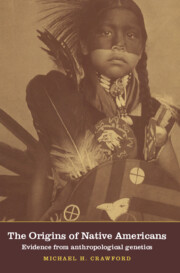Book contents
- Frontmatter
- Contents
- Preface
- Acknowledgement
- 1 Origins of New World populations
- 2 Population size and the effects of European contact
- 3 Demography of Amerindian populations
- 4 Genetic variation in contemporary populations of the Americas
- 5 Population structure of Native Americans
- 6 Morphological variation
- 7 The survivors
- References
- Author index
- Subject index
5 - Population structure of Native Americans
Published online by Cambridge University Press: 01 May 2010
- Frontmatter
- Contents
- Preface
- Acknowledgement
- 1 Origins of New World populations
- 2 Population size and the effects of European contact
- 3 Demography of Amerindian populations
- 4 Genetic variation in contemporary populations of the Americas
- 5 Population structure of Native Americans
- 6 Morphological variation
- 7 The survivors
- References
- Author index
- Subject index
Summary
INTRODUCTION
There are numerous definitions of population structure. Some of these refer to the relationships between the elements within populations, such as genes, genotypes, phenotypes, and groups of individuals (Workman and Jorde, 1980). Schull and Mac-Cluer (1968) include within ‘population structure’ all attributes or parameters of a population (such as geographic, cultural, demographic and social parameters) in time and space. Yet others view population structure as the correction of ideal populations (with properties such as panmixis, infinite size, equal genetic contributions of phenotypes) with real populational characteristics (Cavalli-Sforza and Bodmer, 1971). This latter approach comes from the seminal work of Sewall Wright (1921, 1943, 1945, 1978), who developed much of the theory concerning effects of non-random mating and finite population size. In this chapter, the concepts of population structure will be presented in two parts. First, the effects of small size and non-random mating will be examined within individuals or subdivisions of populations (intrapopulation comparisons). Second, the relationships between populations sharing similar environmental (e.g. geography), temporal (time subdivided by periods) and cultural factors (e.g. languages) will be examined (interpopulational studies). This categorization is imperfect because the lines drawn between populations and subdivisions of a population are often ambiguous. Given sufficient temporal depth, all human populations can be viewed as subdivisions of a single founding population. In fact, the concept of ‘population structure’ may be defined as the totality of factors that interfere with random mating, i.e. population subdivision. Estimates of admixture or gene flow will be considered in the second section of this chapter.
- Type
- Chapter
- Information
- The Origins of Native AmericansEvidence from Anthropological Genetics, pp. 149 - 193Publisher: Cambridge University PressPrint publication year: 1998
- 1
- Cited by



